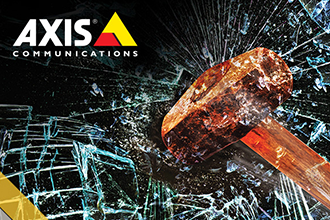Why are customers hesitant to adopt IP video solutions? Even though network cameras have been around since 1996, there’s still a lack of knowledge and understanding among small and medium businesses. Whether they’re first time surveillance buyers or they need to upgrade their old analog system, preconceived ideas are preventing them from choosing IP video. Why are customers hesitant to adopt IP video solutions?
Even though network cameras have been around since 1996, there’s still a lack of knowledge and understanding among small and medium businesses. Whether they’re first time surveillance buyers or they need to upgrade their old analog system, preconceived ideas are preventing them from choosing IP video.
As a security dealer, customers often turn to you for accurate information surrounding today’s security technology. Learn how to address common concerns with these ten debunked network video myths.
Myth #1: Analog and IP technology aren’t that different.
Analog is an older non-digital technology. First used in 1942, analog systems have been beneficial to many businesses for decades. The truth is that analog is dated, and it’s lacking many benefits and advanced functionalities that IP surveillance offers. Compared to analog, IP video solutions:
Only require one cable for power and video using Power over Ethernet
Easily scale from one to thousands of cameras while still providing high quality video
Are capable of live or recorded video remotely from any location
Offer the ability to add intelligence to cameras through analytics
Myth #2: The hype behind IP video hasn’t been proven.
The market has shifted to predominantly IP video with almost all systems fully converged. The demand for IP video has actually reached a level where it’s opening doors for additional devices to converge, such as audio and physical access control. ¹ As IP video benefits advance with technology improvements, add-on devices are also catching up to speed and, in turn, giving dealers like you increased sales opportunity.
Myth #3: IP surveillance only meets the needs of enterprise-level applications.
Back in the early 2000s, network video was defined as the perfect fit for large government and corporate surveillance deals. Now that most of the enterprise market has adopted IP video, there are cost-effective and size-appropriate network video solutions available for small and mid-sized systems. IP video is no longer out of reach for those who are budget-conscious and looking for a simple, manageable system.
Myth #4: Analog image quality is comparable to network video.
IP video image quality is far superior to analog. Since network video images are automatically digitized, images are crisp and work seamlessly with automated analysis and alarm tools. In comparison, analog video images are degraded from traveling over the network, leading to poor image quality that makes it hard for a system or operator to respond. Network video cameras also offer a wide array of technologies that can enhance network video quality for various needs. Technologies include HDTV/4K UltraHD, low-light imaging, forensic imaging, electronic image stabilization, thermal imaging, corridor format and radar technology.
Myth #5: IP solutions are too expensive.
While IP cameras tend to be more expensive than analog cameras, IP video solutions are considerably more cost-effective than analog solutions. Not only are analog installation costs higher, but the cost of management and equipment can be steep. The intuitive and manageable nature of IP video solutions makes it easier for customers to learn and operate, while the open standards of IP video solutions save infrastructural costs. An IP solution also has the capability for integration with analytics and other add-ons, such as audio and physical access control, which makes it a future-proof option.
Additionally, total cost of ownership (TCO) is significantly less in network video systems compared to analog, as network video systems are:
Easier to install
Simple to learn and understand
Low maintenance
Infinitely scalable if a system needs to expand
Myth #6: If your customers already have an analog system, they’re stuck with it.
If customers already have an analog system in place, don’t view it as a roadblock. Analog systems still provide an opportunity for slow upgrades using network video encoders. With this solution, analog video signal converts into a digitized video stream, giving your customers immediate network video benefits. Continue using legacy analog cabling for power and data by connecting them to Ethernet over coax adaptors.
Myth #7: Transferring video data over a network will overload it.
Back when IP video was a newer technology, special precautions would have to be taken to ensure networks wouldn’t be overloaded. Luckily, networks are much more capable to handle large quantities of data. Also, technologies now exist to lower bandwidth without sacrificing valuable information, such as Axis Zipstream.
Myth #8: IP video surveillance isn’t secure.
The topic of cybersecurity is front and center in our industry. Effective cybersecurity is about assessing risks and consequences and taking appropriate steps. One of those steps is ensuring you’re partnering with a supplier that’s prepared to support you at every level and takes extra precautions to ensure their devices are hardened.
With correct security measures, such as firewalls, private networks and strong passwords, the internet can securely transfer network video. In contrast, analog systems have no encryption or authentication of information, making it extremely easy for anyone to tap into the cables and view “secure” video transmissions, or even feed other video information into the network. This is impossible to do with secure IP networks.
Myth #9: IP surveillance isn’t reliable.
Network cameras are extremely intelligent. They can detect interruptions in video transmission and send an alert when such interruptions occur. They can also sense when the lens has been covered or when the position has been tampered with. No need to worry about reliability with IP surveillance systems!
Myth #10: IP video doesn’t fit my business model.
If you’re not already including IP video solutions in your offering, it’s time! The market has matured, and it’s much easier to reach small and mid-sized businesses with solutions tailored to their exact needs. Another benefit of IP video solutions is the potential to upsell a simple solution with audio, physical access control or analytics. The open nature of IP video brings endless opportunities. IP video also has a way of supporting any existing recurring monthly revenue models through services like remote video monitoring and managed video.
IP video surveillance has come a long way since its first introduction to the security market. Network video surveillance solutions offer many benefits over analog systems, and the direction of the market further shows the impact of these advantages.
Join Axis Communications for a webinar on debunking network video myths on Wednesday, May 16th at 1:00pm CDT. We’ll dive deeper into the myths presented above while providing more proof points.
¹Scally, Tim. “State of the Market: Video Surveillance 2018”. SDM Magazine, 1 Feb. 2018.




